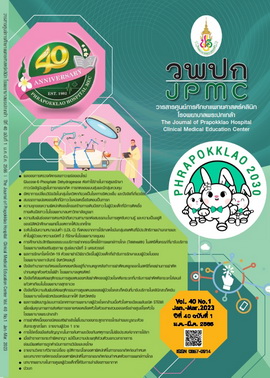Effectiveness of Telehealth in Antenatal Care at Health Promoting Hospital, Regional Health Promotion Center 3, Nakhon Sawan
Main Article Content
Abstract
BACKGROUND: People worldwide have been greatly affected by the ongoing coronavirus disease (COVID-19) pandemic. According to this pandemic, the Ministry of Public Health has a proactive plan to reduce hospital overcrowding; the author developed and implemented a new antenatal care schedule integrating telehealth across all models of pregnancy care.
OBJECTIVES: To assess the effectiveness and safety of telehealth in antenatal care at Health Promoting Hospital, Regional Health Promotion Center 3, Nakhon Sawan
METHODS: The author analyzed routinely collected health data using a quasi-experimental retrospective study. The author assessed the impact of telehealth integration into antenatal care across low-risk care models; the author collected data from both groups from medical records and compared the outcomes. The data were analyzed using descriptive statistics, chi-square, and independent t-test.
RESULTS: Women gave birth during the conventional and telehealth-integrated care periods. Overall, no significant differences were identified in the combined care period regarding the number of babies with low birth weight (birthweight below 2500 gm), the number of stillbirths, fetal growth restriction, and maternal and fetal complications. Telehealth-integrated antenatal care would be appropriate for pregnant women, including safety and effectiveness.
CONCLUSIONS: Telehealth-integrated antenatal care reduced overcrowding in hospitals without bad pregnancy outcomes. This care model can help to minimize in-person interactions during the COVID-19 pandemic but should also be considered in post-pandemic healthcare models.
Thaiclinicaltrials.org number, TCTR20221026001
Article Details

This work is licensed under a Creative Commons Attribution-NonCommercial-NoDerivatives 4.0 International License.
References
Department of Medical Service. The Ministry of Public Health organizes medical services in a new way to reduce congestion and prevent COVID-19 [Internet]. 2020 [cited 2021 Oct 23]. Available from: https://www.dms.go.th/Content/Select_Landding_page?contentId=21659
Adulyatham T. Cloud meeting-telemedicine and health care worker in COVID-19. Journal of the Department of Medical Services 2020;45(2):5-7.
Palmer KR, Tanner M, Davies-Tuck M, Rindt A, Papacostas K, Giles ML, et al. Widespread implementation of a low-cost telehealth service in the delivery of antenatal care during the COVID-19 pandemic: an interrupted time-series analysis. Lancet 2021;398(10294):41–52
Butler Tobah YS, LeBlanc A, Branda ME, Inselman JW, Morris MA, Ridgeway JL, et al. Randomized comparison of a reduced-visit prenatal care model enhanced with remote monitoring. Am J Obstet Gynecol [Internet]. 2019 [cited 2021 Oct 23];221(6):638.e1 638.e8. Available from: https://doi.org/10.1016/j.ajog.2019.06.034
Stephen G, Mgongo M, Hussein Hashim T, Katanga J, Stray-Pedersen B, Msuya SE. Anaemia in pregnancy: prevalence, risk factors, and adverse perinatal outcomes in northern Tanzania. Anemia [Internet]. 2018 [cited 2021 Oct 23];2018:1846280. Available from: https://www.ncbi.nlm.nih.gov/pmc/articles/PMC5954959/pdf/ANEMIA2018-1846280.pdf
Sookdee J, Wanaratwichit C. Factors affecting iron deficiency anemia among pregnant women receiving antenatal care at sub districts health promoting hospital. Journal of Health Science Research 2016;10(1):1-7.
Pereda J, Bove I, Pineyro MM. Excessive maternal weight and diabetes are risk factors for macrosomia: a cross-sectional study of 42,663 pregnancies in Uruguay. Front Endocrinol (Lausanne) [Internet]. 2020 [cited 2021 Oct 23];11:588443. Available from: https://www.ncbi.nlm.nih.gov/pmc/articles/PMC7669744/pdf/fendo-11-588443.pdf

